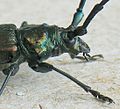Musk buck
| Musk buck | ||||||||||||
|---|---|---|---|---|---|---|---|---|---|---|---|---|

Musk buck ( Aromia moschata ) |
||||||||||||
| Systematics | ||||||||||||
|
||||||||||||
| Scientific name | ||||||||||||
| Aromia moschata | ||||||||||||
| ( Linnaeus , 1758) |
The musk buck ( Aromia moschata ) is a species of beetle and belongs to the longhorn family . It is the only representative of the genus Aromia that is native to Europe . The name of this type of beetle can be traced back to a strong musky smelling secretion that the animals can secrete from the rear breasts. This was formerly the perfuming of pipe tobacco used.
The Asian musk longhorn beetle ( Aromia bungii ) in the same genus is a dangerous tree pest that was introduced to Italy and Germany in the area around Rosenheim in southern Bavaria.
features
The beetles are 15 to 34 millimeters long, and individual specimens can reach a size of 40 millimeters. The color of their shiny metallic bodies varies. Some musk bucks have a copper or bronze shimmer, others are blue-violet or greenish. In the male animals, the antennae are longer than the body. In the female animals these are shorter than the body or body length. The eyes of the musk bucks grow around the antenna base from behind, because the solid anchoring of the long and strong antennae and the muscles to move them take up a lot of space and do not give the eyes enough space to develop into a round shape. The pronotum of the musk bucks is thorny. Both features can be seen on the adjacent detailed photo.
Way of life
The fully grown musk rams ( adults ) feed on pollen and sap flowing out of trees. Therefore, the animals can be found on blossoms in forests , especially in hardwood and softwood meadows rich in dead wood , gardens or parks . Because of their size, they prefer flower umbels, such as those from the black elder . The adults only live a few weeks in summer. The beetles are found from June to August.
Larval development
The larvae of the musk billy goat need two to three years to develop into adult beetles. During this time, xylobiont prefer to feed on willow wood . But other soft woods such as poplar or alder are also attacked. Eggs are particularly often laid on older, already fragile trees. An ideal habitat for this species of beetle are pollarded . But also alluvial forests and alder quarries are excellent “nurseries” for the musk buck.
Occurrence
The beetles can be found all over Europe and the temperate zones of Asia .
Habitat, endangerment, protection
Due to the decline in branches of business such as basket weaving, the care and management of polluted willows has declined sharply. Due to drainage and intensive forestry use, there are fewer and fewer alluvial forests and alder swamps in which the larvae can develop. These factors have led to a noticeable decline in the population. In accordance with the BNatSchG and BArtSchV, the musk billy was therefore granted the protection status “particularly protected”. Nature conservation organizations, such as NABU or BUND , maintain existing stocks of polluted willow trees in order to ensure survival for the musk buck, among other things. It is also helpful if ailing trees - for example poplars - are not felled immediately and deadwood is not cleared from forests too thoroughly .
literature
- Jiři Zahradnik, Irmgard Jung, Dieter Jung, Jarmila Hoberlandtova, Ivan Zpevak: Beetles of Central and Northwestern Europe. Parey, Berlin 1985, ISBN 3-490-27118-1





